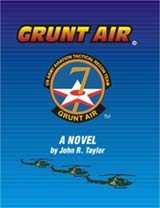






  |
Grunt Air Synopsis
|
 |
The StorylineJust after Washington and the U S Ambassador to Laos authorized the formation of crash site teams, the Commanding General of the 7th Air Force put together an elite combined forces unit using the very best ground reconnaissance and intelligence support personnel he could find, in direct support of combat veteran Army helicopter pilots. The unit, nicknamed "Grunt Air" by the Air Force boys, was formed in late July 1971, and deployed to Udorn Royal Thai Air Force Base in Thailand. By day, Grunt Air flew crash site missions while secretly locating downed pilots who were being held in the northern part of Laos and the Plain of Jars. To avoid suspicion, Grunt Air would fly back to Udorn each night just as any non-aggressive, purely technical team would do. The original commander of Grunt Air was a by the book professional, good at administration but lousy at combat. The Commanding General soon replaced this "staffer" with Dan Roman, an irreverent Army Captain flying combat assault missions in the Mekong Delta. Previously, Roman had flown clandestine counterinsurgency missions for the same General in Colombia. It was this impressive history of flying unorthodox and dangerous operations that made the General transfer Roman to the Grunt Air operation. Roman was a no-nonsense, get-it-done type leader whose zero tolerance for unrealistic regulations and naive, egotistical "staffers" often landed him in trouble. In short, Roman was the perfect man to lead a rebel helicopter unit on clandestine rescue missions through enemy lines. Not long after its formation, Grunt Air located three POWs in a North Vietnamese prison camp called "The Homestead." The NVA had captured the officers - an American, an Australian and a South Vietnamese - and were holding them at a point along the route to Hanoi. Grunt Air sent news about the POWs to the Commanding General who soon discovered that these three officers were regarded as high priority captives. The officers had knowledge of sensitive information that could under no circumstance reach enemy commanders in Hanoi and Moscow. Their fate was sealed: either Grunt Air rescue these men or a B-52 strike would be ordered to take care of them. Inspired by Dan Roman's obsession about leaving no man behind, the Grunt Air team committed itself to keeping track of the three prisoners and springing a rescue when the time was right. The caveat and key to the whole operation was that nothing could in any way compromise Grunt Air's secret mission. Its real objective had to remain a secret. Otherwise, "staffers" would shut the unit down. Roman ordered his recon teams to search the Plain of Jars for other POWs while they kept track of the NVA's three high priority captives. Roman patiently devised a plan to rescue the officers before they checked in to the notorious Hanoi Hilton prison or was blown into oblivion by the B-52s. During this time, Roman took on other missions, including an extreme makeover of Grunt Air's hand-me-down, ramshackle barracks and the harrowing rescue of three CIA agents who had become trapped behind enemy lines in Cambodia. Meanwhile, back in the States, the distraught wives of two American POWs pressed for a full accountability of all prisoners in Vietnam, charging North Vietnam with rampant violations of the Geneva Convention and the U.S. with stonewalling the POW issue for the sake of a quick peace treaty. In their effort to protect their husbands, the dauntless women challenged the beleaguered U.S. diplomatic corps to be more assertive with the North Vietnamese, skirted the advances of an adulterous Pentagon POW family representative and, with the help of a sympathetic Senator, confronted the North Vietnam peace accord delegation at a televised stand off in Paris. All this while trying to keep a semblance of normalcy in the home and raise their teenaged children. In December 1971, the North Vietnamese Army started an all-out offensive to take over Laos. Grunt Air's deployed recon units in northern Laos were situated in very highly advantageous and strategic position. Not only could the Grunt Air recon teams follow the transfer of the three high-priority POWs but they were also able to monitor the advance of the NVA and provide real time intelligence to Headquarters 7th Air Force. On several occasions, Grunt Air teams obtained critical intelligence when they captured and interrogated NVA and Russian military personnel. From their strategic vantage point, Grunt Air recon teams were able to report tactical information that otherwise would not have been available because the Top Brass had restricted hostile U.S. military action in the area. Using intelligence obtained from these reconnaissance operations, Dan Roman concocted a daring plan to bait the NVA into moving the three POWs to "The Big Casino," a camp near the NVA Headquarters for Laos at Sam Neua just 22 miles from the North Vietnam border and 125 miles from Hanoi. Roman felt that the camp was so far into NVA held territory that it would be lightly guarded and vulnerable to a surprise attack. Roman's deception plan worked and the NVA took the bait. They moved the prisoners to "The Big Casino" thinking it was the safest place to hold the POWs before moving north to Hanoi. This was the decision Roman wanted the NVA to make; it was the decision that would make a surprise rescue mission possible. At great risk to his career, the Commanding General approved Roman's plan, giving Grunt Air the go-ahead to extract the POWs. On the night of January 19th, 1972 within sight of the lights of Hanoi, Grunt Air launched their Hueys at "The Big Casino."
|
 |